BIRDS IN CHINA
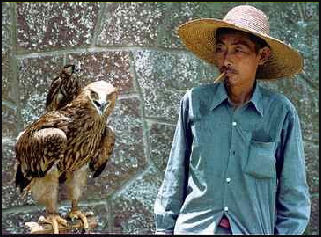
An eagle in Yangshou in Guilin More than 1,000 species of birds have been recorded in China. Among the rarer kinds are the golden pheasant, Derby's parakeet, the white-crowned long-tailed pheasant, yellow-backed sun-bird, red-billed leiothrix, and red-crowned crane. [Source: Worldmark Encyclopedia of Nations, Thomson Gale, 2007]
In February 2004, around 10,000 birds suddenly dropped dead from the sky. The birds were bramblings, a member of the finch family, and it is said they dropped “like rain.” It is not clear what made them all die. Scientists have speculated they were poisoned.
Storks have been raised in artificial breeding programs in Russia and China and imported to Japan. An owl in the southern province of Jiangxi built a nest in a farmer's house so it could watch TV every night with the farmer's family.
The Chinese crested tern is one of the world’s rarest birds. It is seen in Fujian Province. An NGO called the Saunder’s Gull Protection Association, founded by Liu Detian, has proposed setting up the world’s largest breeding wetland in the 3,149-square-kilometer Panjin wetland in Liaoning Province wetland. Another gull, the Saunder’s gull is one of the rarest birds in China.
Birds in Tibet See Separate Article TIBETAN ANIMALS AND PLANTS factsanddetails.com Articles on ANIMALS IN CHINA factsanddetails.com
Websites and Sources: Rare Birds of China rarebirdsofchina.com ; Birds of China Checklist birdlist.org/china. ; China Birding Hotspots China Birding Hotspots China Bird.net China Bird.net ; Fat Birder Fat Birder . There are lots of good sites if you google “Birdwatching in China.” Cranes International Crane Foundation savingcranes.org; Animals Living National Treasures: China lntreasures.com/china ; Animal Info animalinfo.org ; Endangered Animals in China ifce.org/endanger ;Plants in China: Flora of China flora.huh.harvard.edu
RECOMMENDED BOOKS: “A Field Guide to the Birds of China” by John MacKinnon and Karen Phillipps Amazon.com; “China Birds: A Folding Pocket Guide to Familiar Species” by James Kavanagh and Waterford Press Amazon.com; “Birds of China” (Pocket Photo Guides) by John Mackinnon and Nigel Hicks Amazon.com; “China Red Data Book of Endangered Animals-Aves” by Zheng Guangmei and Wang Qishan Amazon.com; “Birds of the Himalayas” (Pocket Photo Guides) by Bikram Grewal and Otto Pfister Amazon.com; “Chinese Wildlife” ( Bradt Travel Wildlife Guides) by Martin Walters Amazon.com; “Guide to the Wildlife of Southwest China” by William McShea, Sheng Li, et al. Amazon.com; “Wildlife Wonders of China: A Pictorial Journey through the Lens of Conservationist Xi Zhinong” by Zhinong Xi, Rosamund Kidman Cox, et al. Amazon.com
Birdwatchers and Birdcatchers in China
Birdwatchers are often mistaken for surveyors. When they identify themselves they are often told there are no birds or asked how expensive the birds they are looking for. A well-known birder in Shanghai old The New Yorker, “Whatever species you can find in the forest you can go to local market and see in a cage.”
Birds are threatened by pollution, habitat loss, and widespread illegal netting and poisoning of them for food. Wild birds are commonly caught and sold as pets or for release at festivals by Buddhists, who believe that releasing caged birds brings good karma.
In a typical Chinese bird market you can recently caught thrushes, skylarks and grosbeaks, looking ragged in their cruelly-small cages. Sometimes sparrows are kept on leashes by children who tame the birds by quietly stroking their heads. Budgies and minias are often raised in captivity. Exotic birds like fallvettas, leaf birds and yhina and caught in the south and transported to the north,
Among the birds favored for their songs are tiny Japanese white-eyes and hwamei. Newly caught birds sell for as little a $1.50 but ones who have been trained for a year fetch as much as $300. The white-eyes tend to be kept in nice, elegant cages while the hwamei are kept in more spartan solid-sided cages.
Bird Netting in China
Every fall, almost the entire migratory bird population of northeast China funnels through the Liaodong Peninsula on their way south. Local poachers put up thousands of nets, many of them on public land, including Laotoe Mountain Nature Reserve, to capture and kill them. Some are eaten locally but most are sent to southern China, where they are regarded as delicacies.
Among the most value birds are white-tailed eagles, valued because eating them is thought to improve eyesight, and Saker falcons, prized by falconers. Some birds survive the netting unscathed but others are killed or suffer compound fractures that send their bones piercing out of their wings at sickening angles. Poachers often stuff a day’s catch — including live birds and dead one — into laundry sacks. Hawks and eagles are decapitated to keep them from biting. Some times the most visible evidence that poachers have struck a certain area is small pile of bloody heads left on the ground.
The nets are sometimes hung between the tops of two trees. Small birds in cages are sometimes used as bait to attract larger birds. Some eagle traps are hung from high branches and weighted with logs. Reserve wardens try to catch the poachers, who respond by chopping down trees to block the warden’s trucks. The wardens also try to educate the public that in the long run birds are worth more alive than dead and also try to generate interest in developing eco-tourism.
Well-Known Birds in China
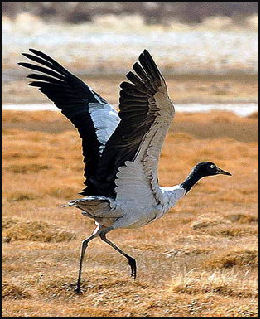
black necked crane
Spotted-necked doves (Streptopelia chinensis) have a full body length of 32 centimeters and weigh 125-180 grams. They live in plains and in open woods in mountain areas. They peck food on the ground with their bills and eat seeds of crops, grasses and some insects. They can be found all over China. Doves are non-migratory birds that tend to stay in one area. Spotted-necked doves like to spend their time in villages or fields and nest their young from May to July. They build simple and flat nests with small twigs in forks of tree branches. They generally nest two eggs at a time. After young birds are hatched, their parents can change the digested foods in their breasts into a special kind of dove food to feed their young. Their calls vary. Their normal vocalizations are described by the Chinese as "gu, gu". It is said their songs are most frequent during the sunshine after a long rain or when it's going to rain after a long sunshine. [Source: Center of Chinese Academy of Sciences, kepu.net.cn]
River Kingfishers (Alcedo atthis) have a full body length of 15 centimeters and weigh 21-30 grams. They live in streams, lakes, rivers and fishponds. They catch prey with their bills by diving into the water and eat fish, shrimps, aquatic insects, and shellfish. They can be found all over southern and eastern China. Non-migratory birds, they spend their time in pairs or alone and stay on trees or rocks near bodies of water. When they see small fish near the water surface, they would dive into the water surface to catch them and then fly back to the tree or rock where they originally were to eat the fish. The dig tunnel-like dens in sand or mud banks to nest their eggs and feed their young there. Because of their unique way in getting food, people call them "fishermen".
Red-whiskered Bulbuls (Pycnonotus jocusus) are 20 centimeters long and weigh 30-40 grams. Their preferred habitats are villages, woods and bushes near farm fields and parks of cities. These birds peck food on branches of trees or catch flying insects. When flying they carry seeds and insects. Red-whiskered bulbuls are normal non-migratory birds and they like to spend their time in groups. Red-whiskered bulbuls build their nests in trees from March to August each year. Because they have high crest, they are commonly called "high crest bird". Their singing is light and melodious and they are regarded as fancy birds in Guangdong province. They can be found in southern China.
Melodious laughing thrushes (hwamei, Garrulax canorus) are 23 centimeters long and weigh 50-75 grams. They live in forests in mountain areas, bushes and bamboo woods near villages. They get food from tree branches and bushes with their bill and eat insects and berries and seeds of some vegetation. They can be found all over Central and South China. Hwamei can be solitary or live in pairs. The build a bowl-shaped nests with stems and leaves of vegetation from April to July each year and nest 3-5 eggs each time. Hwamei get their name because there are white stripes around their eyes, which stretch towards behind the eyes like a white brows. Normally, their feathers are brown. In humid tropical areas, their feathers may become black. Black Hwamei are all black, but their brows are white.
Male Hwamei are good at singing and their voice are very elegant and melodious. They are regarded as a distinguished and famous fancy bird. Hwamei can fiercely defend their territories. Because of this, hunters often place tamed Hwamei in these areas. When the wild Hwamei try to fend off the intruders hunters catch them with nets. Hwamei can be tamed but raising their eggs in captivity is quite difficult. For this reason Hwamei that are tamed are caught in th wild. So many Hwamei have been caught that the number of wild ones has been greatly reduced.
Endangered Birds in China
Lord Derby's Parakeet (Psittacula derbiana) are endemic to and are only parakeet species found so far north. They are 45 centimeters long and weigh 260 grams. Their preferred habitats are coniferous forests, broad-leaved forests or mingled forests. They crack nuts and get the seeds with their hard bill and eat fruits, pine nuts, corn, sunflowers and other crops. They can be found in Sichuan, Yunnan and Tibet and are regarded as an endangered species. Lord Derby's parakeets normally spend their time in small groups. In the mating season, pairs build their nests in holes of trees. These birds nest in high mountain areas fly to the south or low altitude river valleys to spend winter in autumn. The upper bill of male parakeets is red and the lower bill is black. Female birds have black bills. With some training, Lord Derby's parakeet be taught to imitate words and speech of people. They are regarded as fancy birds and can be raised in cages. [Source: Center of Chinese Academy of Sciences, kepu.net.cn]
Golden pheasants (Chrysolophus pictus) are brilliantly colored and reclusive birds also known as the “fire phoenix” or Chinese pheasant. They live in forests, bamboo woods and bushes in low and middle height mountain areas. Male golden pheasant have a body length of about one meter; females, 50 centimeters. Adults weigh 650 grams. These birds peck with their bills or scratch on ground surface then peck and eat young shoots, leaves, flowers, fruit of vegetation and insects. Their natural habitats are limited to mountain areas in central and mid-south China.
Golden pheasants are non-migratory birds and endemic species of China. Male golden pheasant are one of the most beautiful fancy type pheasants. Baoji city of Shanxi province get their name from these birds. Around 200 years ago, Westerners introduced golden pheasants into Europe. They are now the most commonly raised pheasant in zoos. Normally, golden pheasants spend their time in small groups and stay in forests. During their mating season, male golden pheasants occupy a piece of land and utter sounds like "ga, ga" to attract females. After mating, female golden pheasants build their nests in secret places of the forests where they nest eggs and hatch their young alone. Males are the colorful ones. In comparison, females dull. They are completely brown with dotted with black spots. Females have no feather crests and wraps. Their colors serve them well when they hide themselves and watch over their eggs and raise their young..
Golden pheasants are rarely spotted in the wild. One was seen in central China in 2019. The South China Morning Post reported: “Golden pheasants have been made a rare appearance in a snowy habitat in China’s central province of Henan.[Source: Center of Chinese Academy of Sciences, kepu.net.cn]
Ducks and Water Birds in China
Common shovellers (Anas clypeata) are middle-sized wild ducks that are around 50 centimeters long and weigh 420-620 grams. Their preferred habitats are ponds, reservoirs, rice fields, marsh and bays. They dig food from mud with their bill or get food by filtering in water and eat small mollusks, roots, stems and fruit of vegetation. They can be found all over China. They are migrating birds. They nest their young in Northeast China and Xinjiang and spends their winter in the South. They live together with other wild ducks in winter. Their bills are quite special. The front part is quite broad. Common shoverller mostly get their food by filtering in mud. They are quite different with other wild ducks in this respect. [Source: Center of Chinese Academy of Sciences, kepu.net.cn]
Little grebes have a full body length of 27 centimeters and weigh 210 grams. They live in lakes, rivers, ponds and marsh. They catch prey with their bill in water and eat aquatic insects, fish, shrimp and aquatic vegetation of various kinds. They can be found in most places of China. They are non-migratory birds and often are solitary but are also found in groups. They are clumsy at flying but are good at swimming and diving and can build floating nest in water, which rise and fall with the water level. When dangers occur, they hide their young under their wings and dive into the water to escape. They often utter cries in early morning and at dusk. During the mating seasons, the feathers around their neck change to dark red. Their feather become light colors in winter.
Billions of ducks are raised in China for their meat. The majority of them are white Peking ducks (introduced to the United States from China in 1870) raised on small farms with ponds. Domestic ducks sometimes breed with mallard ducks producing strange-looking hybrids.
See Separate Articles DUCKS, DAIRY COWS, FOIE GRASS AND LIVESTOCK IN CHINA factsanddetails.com
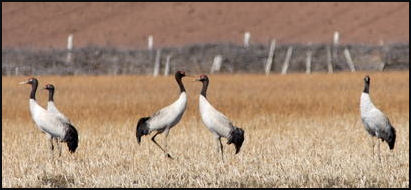
Black- Necked Cranes
Mandarin Ducks
The mandarin duck, or Chinese wood duck, is an unremarkable-looking bird most of the year, with a grey head and dappled brown body. But during the mating season it goes through a remarkable transformation. The top of its head turns glossy green, a ruff of pointed feathers sprout from around the neck and triangular sails emerge from the wings. In the their display in front of females, males gather in groups and dip their bills in the water, arch their necks and touch the sails on their wings with their bills.
Mandarin ducks (Aix galericulata) are middle-sized duck with a full length of 40 centimeters and weigh 630 grams. They live in streams in mountain areas, river valleys, lakes and marshland and eat fruit, crops and other vegetation, fish, shrimp, frogs and other small animals. They can be found in northeast, south and east China. They are regarded as threatened not endangered species.
Mandarin ducks are migrating birds. They spend their time in pairs at the mating season, and at other times. They can also be found in small groups and nest their eggs and hatch them in tree dens near streams or ponds from April to June each year. Small Mandarin ducks become agile swimmers soon after they are hatched and they jump into water together with their parents to amuse themselves and to seek food. The birds nest their young in the northeast in summer and spend their winter in the middle and down stream areas of the Yangtze River. Mandarin ducks live all year round in some mountain areas of South China, ,and are regarded as resident birds there.
According to Chinese folklore, when a pair of Mandarin ducks becomes husband and wife, they love each other for the rest of their life. Chinese people often regard them as the symbol of love. The Mandarin Ducks and Butterflies school was a popular genre of Chinese fiction in the first half of the 20th century, especially in the 1920s. Mandarin ducks (which are frequently seen in pairs) and butterflies (from Butterfly Lovers) are traditional symbols of romantic love. Mandarin Ducks and Butterflies stories were disparaged by progressive writers as being essentially escapist and showing no social responsibility. The genre gradually fell out of favor following Japanese invasions in the 1930s. [Source: Wikipedia]
Cranes, Ibises and Storks in China
The black-necked crane is named after the black coloring on the bird's neck and head. Standing 90 to 130 centimeters tall, with a wingspan of 180 to 200 centimeters and weighing between 6 to 9 kilograms, these large birds have a bright red crown and feed primarily on barley. Tibetans regarded them as holy birds. The black-necked crane inhabits high altitude wetlands on the Qinghai-Tibetan Plateau during the April-to-October breeding season and winters in low elevation agricultural valleys in primarily in China.
The red-crowned crane is the official bird of China. Among the largest cranes, it stands nearly five tall, weighs 22 pounds and lives more than 60 years. Males and females are virtually identical. Booth have distinctive red crowns and white and black markings on their wings and bodies. They are also known as the Japanese crane and Manchurian crane.
The white-naped crane is named after the white stripe that runs along the bird's neck. Standing up to 1.5 meters and weighing between 4.75 and 6.50 kilograms, these large birds inhabit wetlands and adjacent grasslands in China, eastern Siberia (near Vladivostock), southern Japan and the demilitarized zone between North and South Korea. Predominately grey, with a red spot around their eyes, white-naped cranes are monogamous. The incubate two eggs which hatch in about 30 days. Only about 4,900 to 5,300 of the birds remain. Their existence has been threatened by loss of habitat and disruption of migration patterns.
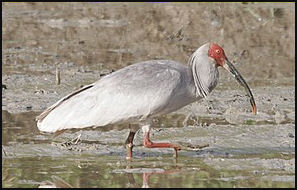 Black storks (Ciconia nigra) are large wading bird that are over one meter long and weigh 2.5-4.4 kilograms. Their preferred habitats are open marsh, lakes, shoals of rivers and flooded fields. They catch prey with their bills by quickly pecking at them in shallow water and gobbling them up. They eat fish, shrimps, frogs, and crabs. They are rare migrating birds that nest their young in North China during summer and autumn, and fly to the South to spend winter. The birds spend their time in groups during migration but they usually are solitary at other times. In their mating season, the birds spend their time in pairs. Black storks build their nests in cracks of stones or on big trees. Black storks nest 3-5 eggs each time. The male and female raise their young together. They cannot utter cries but they can produce sounds by clapping their upper and lower bills. The number of black storks in wild state is shrinking. They are regarded as an endangered species. They can be found in different places of China.
Black storks (Ciconia nigra) are large wading bird that are over one meter long and weigh 2.5-4.4 kilograms. Their preferred habitats are open marsh, lakes, shoals of rivers and flooded fields. They catch prey with their bills by quickly pecking at them in shallow water and gobbling them up. They eat fish, shrimps, frogs, and crabs. They are rare migrating birds that nest their young in North China during summer and autumn, and fly to the South to spend winter. The birds spend their time in groups during migration but they usually are solitary at other times. In their mating season, the birds spend their time in pairs. Black storks build their nests in cracks of stones or on big trees. Black storks nest 3-5 eggs each time. The male and female raise their young together. They cannot utter cries but they can produce sounds by clapping their upper and lower bills. The number of black storks in wild state is shrinking. They are regarded as an endangered species. They can be found in different places of China.
The rare crested ibis was thought to be extinct in the 1970s. In 1981, seven of the birds were found living in the mountains of Yang Prefecture in Shaanxi province. In 1990, the Shaanxi Crested Ibis Rescuing and Breeding Center was set up. Through protection and artificial insemination, scientists have been able to raise the number of crested ibises to 300 through captive breeding and have released some into the wild. The crested ibis is a beautiful bird with white feathers, a red face and a black downward curving bill. Indigenous to Japan, Korea, eastern China and eastern Russia, it is a wading bird that makes its home in rice paddies and marshes. The crested ibis is stockier and have shorter legs that the egrets and herons. In the autumn and winter their plumage turns a pinkish-peach "ibis color." They feed on a large variety of mud-dwelling creatures, particularly loaches.
cranes and black-necked cranes See Separate Article CRANES factsanddetails.com; Red-crowned crane See Separate Article JAPANESE CRANES (RED-CROWNED CRANES) factsanddetails.com
Jungle Birds in China
Wild Peafowl (peacocks) can be found in China, mostly in Yunnan Province. Jungle fowl (the ancestors of chickens). They can be found in Central and South Yunnan, Guangdong, Guangxi and Hainan. Both are regarded as threatened not endangered species. In some mountain areas in Yunnan, red jungle fowls often enter the household to join household raised fowls and would chase the family cocks away then mate with hens. The young chickens thus produced are rather fierce and would run into forests when grow up a little. As early as 2000 years ago, our ancestors had tamed red jungle fowls.
Chinese jungle mynah (Acridotheres cristatellus) have a full body length of 26 centimeters and weigh 100-150 grams. Their preferred habitats are fields, grassland and villages. These birds peck food on the ground with their bill and eat insects, earthworms, ferry and seeds of vegetation. These non-migratory birds that tend to stay in one area. When flying, you can see white stripes on their wings, which resembles the shape of a Chinese character "ba" — the source of their Chinese name, “ bage”. They spend their time in small groups and they build their nests in holes or tree hollows and raise their young there. Chinese jungle mynah are good at imitating human language and often raised by humans. Chinese jungle mynah can be found all over Yunnan and in southern the central China and the lower Yangtze River.
Lady Amherst's pheasant (Chrysolophus amherstiae) live in forests and bushes in low, middle and high mountain areas. Male birds are 1.2 meters in length; females are 60 centimeters long. They weigh 600-800 grams. These birds peck with bills or scratch on ground surface then peck and eat young buds, leaves, flowers, fruits, mushrooms, termites and locusts. They can be found in most places in Yunnan and mountain areas in Southwest China. They are regarded as threatened not endangered species.
Lady Amherst's pheasant are non-migratory birds that tend to stay in one area. Normally, they spend their time in small groups in forests. During mating season, males occupy a piece of land and utter sounds like "ga, ga" to attract females. After mating, females build a nest in secret places of the forests to nest eggs and to hatch their young alone. The calls of the bird come a great variety. When they communicate with one another, they make noises like "hush, hush"; when they feel dangers, they make cries like "Xiya" to give warning. When mother birds are looking for their young, they make sounds like "guo, guo"; and young birds respond with "ji, ji". Lady Amherst's pheasant are distributed in mountain areas of Southwest China and are only seen in Northeast Myanmar outside of China.In the early 1800s, the British brought the birds to London. Golden pheasants, which are found in China, and Lady Amherst's pheasants are regarded as the most beautiful fancy types pheasants. Many zoos have them.
See Separate Article BIRDS IN ASIA: JUNGLE FOWL (CHICKENS), KINGFISHERS AND PEACOCKS factsanddetails.com
Cormorants and Cormorant Fishing
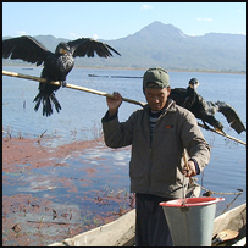
Cormorants are waterbirds, whose name means "crows of the sea." A member of the pelican family, they can fly at speeds of 50mph and are particularly adept at swimming underwater, which is why they are such skilled fish catchers. They feed mostly on fish but also feed on crustaceans, frogs, tadpoles and insect larvae. [Source: Natural History, October 1998]
There are 28 different cormorant species. They live mainly in tropical and temperate areas but have been found in polar waters. Some are solely saltwater birds. Some are solely freshwater birds. Some are both. Some nest in trees. Others nest on rock islands or cliff edges. In the wild they form some of the densest colonies of birds known. Their guano is collected and used as fertilizer.
Described by Marco Polo and popularized in the children's story Ping, cormorant fishing is still practiced today in some parts of southern China and Japan, where it first evolved. The best time to view cormorant fishing is on a moonless night when the fish are attracted to lights or fires on the boats. The cormorants go through a routine of diving, catching fish, surfacing and having the fish taken out of their mouth by the fishermen. A piece of string or twine, a metal ring, a grass string, or a hemp or leather collar is placed around their necks to prevent them from swallowing their fish. The birds often have their wings clipped so they don’t fly away and have looped strings attached to their legs that allow them to be retrieved with a pole by the fisherman.
See Separate Article CORMORANTS AND CORMORANT FISHING factsanddetails.com
Decline of Sparrows and Swifts in China
The number of sparrows in China has sharply declined as a result of pollution and hunting. Large numbers of them have been caught and fried up and served up as snacks in the streets of Beijing and other cities. Others have been poisoned by pesticides. Not very many Chinese have mourned their loss. In the late 1950s, Mao put them on the list of “four pests” along with rats, mosquitos and flies that should be exterminated.
According to Danwei.org: “Not so long ago summer in Beijing simply wasn't summer without the constant screaming of swifts over the gates and hutongs, but in recent years the skies have fallen silent due to the wholesale destruction of traditional buildings and ever growing pollution. Swifts - (“rain swallows”) or (“pagoda swallows”) in Chinese - have been synonymous with Beijing since 1417 - indeed an alternative name for the city is Yan Jing or “swift capital.”...The old-style courtyard buildings, temples and city gates were ideal nesting places for these acrobatic harbingers of summer, and the concrete and steel monstrosities that have replaced them have proved disastrous for the birds which come to breed in Beijing after spending the winter as far away as southern Africa.” Professor Zheng Guangmei of Beijing Normal University, chairman of the China Ornithological Society, recalls cycling past the moat around the Forbidden City in June 1965 and seeing almost 400 of the dark, swallow-like birds. But when another expert, Gao Wu, a retired zoology professor from Capital Normal University, counted swifts at the same spot in July 2000 he noted only 80.” [Source: Danwei.org, August 24, 2009]
“The swift's demise seems to date back as far back as the early 1950s when the city gates started to be demolished, the first to go being Chang'an Left and Right Gates in 1952, and by the time Dongzhimen was razed in 1969 it seems to have been too late. “At the same time temples and pagodas were also demolished for various reasons,” says Gao. “Suitable habitats for swifts gradually disappeared, which is the main reason why their numbers have fallen. But worse was to come, and the birds' fate was sealed in the 1980s when some of the relatively few old buildings that had survived the destruction of the Mao era were renovated and netting was placed around the eves to protect them from birds. Not only this, but vast forests of concrete and glass high-rises were built that were even more hostile territory and have resulted in further declines in swift numbers.”
“The Bird's Nest stadium and five statues inspired by swifts were symbols of the Beijing Olympics that should have been good news for birds, but in fact the Bird's Nest was particularly hostile territory for swifts as it was surrounded by concrete-covered squares that were totally unsuitable habitat...A few flyovers, including those at Temple of Heavenly Peace and Jianguomen, have managed to attract nesting swifts, but by and large the outlook seems bleak. Gao says attempts to “green” Beijing through the unimaginative planting of vast numbers of alien evergreens and the excessive manicuring of parks and other green spaces have been a disaster for swifts and other indigenous species. What’s more, many officials in charge of preserving ancient buildings are totally unsympathetic to the needs of birds. When Gao raised the matter of how netting around the eves prevents swifts from nesting, one of them sneered, “They're pests, why should they be protected?”
Image Sources: 1) Beifan.com; 3) Travelpod; 4) China Tibet Information; 5) Birdquest, Mark Beamon; 6) Jane Yeo Tours ; 7, 8) The Wanderer Years ; 9) WWF; 10) Nolls China website http://www.paulnoll.com/China/index.html
Text Sources: New York Times, Washington Post, Los Angeles Times, Times of London, National Geographic, The New Yorker, Time, Newsweek, Reuters, AP, Lonely Planet Guides, Compton’s Encyclopedia and various books and other publications.
Last updated July 2022
